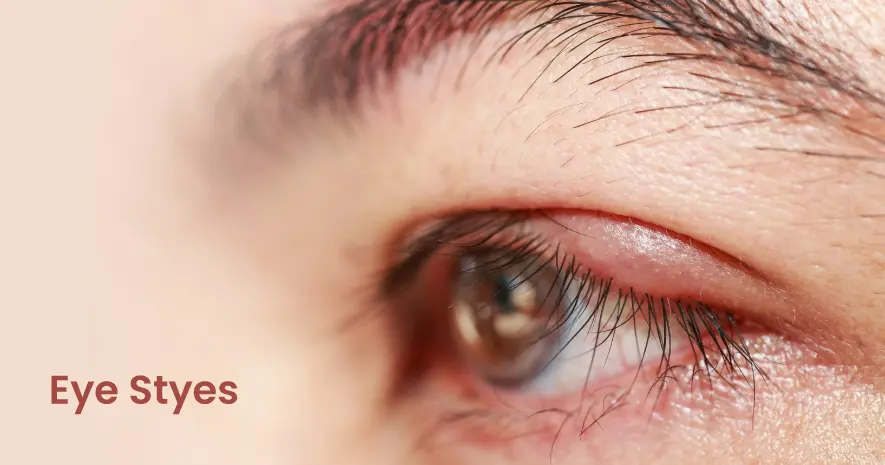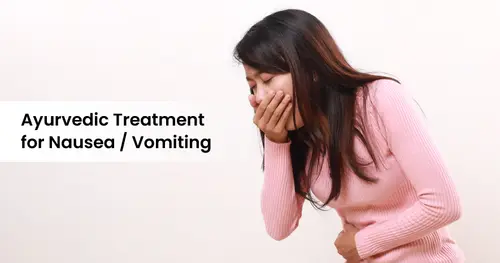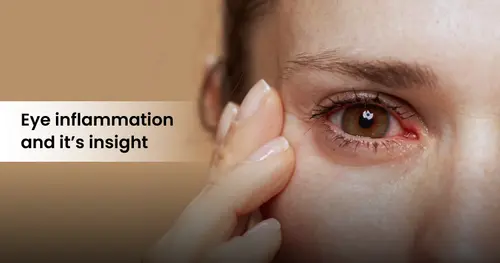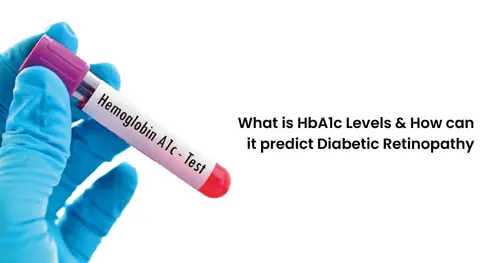
Eye styes, or hordeolum, are common yet discomforting inflammatory conditions affecting the eyelid margin. These painful, red swellings occur due to bacterial infection, often involving Staphylococcus aureus, or obstruction of sebaceous glands. In modern ophthalmology, a stye is classified as either external (affecting the glands of Zeis or Moll at the base of the eyelashes) or internal (involving the deeper meibomian glands within the tarsal plate). While generally self-limiting, untreated styes can lead to complications such as chalazion, preseptal cellulitis, or recurrent infections, particularly in individuals with underlying systemic imbalances.
Ayurveda provides a deeper, more holistic interpretation of eye styes, referring to them as Anjananamika, a condition classified under Vartmagata Rogas (diseases of the eyelid). Classical Ayurvedic texts describe Anjananamika as a copper-colored, painful, and pustular swelling arising due to imbalances in Pitta dosha, with associated vitiation of Rakta (blood tissue) and Mamsa (muscle tissue). The pathogenesis of Anjananamika aligns with the Ayurvedic principle that localized inflammation is often a reflection of systemic disharmony, particularly aggravated Pitta-Rakta dosha, poor digestion (Agnimandya), and accumulation of metabolic toxins (Ama).
By integrating the modern scientific understanding of styes with Ayurvedic pathophysiology, this discussion provides a comprehensive overview of causes, symptoms, and treatment approaches, emphasizing Ayurveda’s ability to address both immediate discomfort and the underlying predispositions that lead to recurrent infections.
The Etiology and Pathogenesis of Eye Styes:
From a biomedical perspective, a stye develops when bacteria infiltrate the sebaceous glands of the eyelid, leading to localized infection, inflammation, and accumulation of pus. The obstruction of oil-secreting glands contributes to bacterial proliferation, creating an ideal environment for infection. Common predisposing factors include poor eyelid hygiene, frequent eye rubbing, cosmetic contamination, immunosuppression (as seen in diabetes or chronic illnesses), hormonal fluctuations, and meibomian gland dysfunction.
The Ayurvedic interpretation sees Anjananamika as the result of Pitta aggravation, which overheats the Rakta dhatu (blood tissue), creating an inflammatory response in the eyelid. Poor dietary habits—such as excessive intake of spicy, oily, fried, and acidic foods—increase Pitta dosha, predisposing individuals to conditions involving excess heat and localized suppuration. Additionally, poor digestion and the accumulation of Ama create an internal milieu prone to recurrent infections. External factors such as improper hygiene, excessive screen exposure, and pollution further contribute to Vata-Pitta derangement, leading to impaired ocular immunity and glandular dysfunction.
Symptoms and Clinical Manifestations
The presentation of a stye is distinct and progresses in phases. Initially, a localized redness and swelling appear along the eyelid, accompanied by tenderness, itching, and a sensation of heaviness. As the infection progresses, a yellowish pustule may develop, signifying pus accumulation. Some patients may experience photophobia (sensitivity to light), excessive tearing, and a foreign body sensation. While styes typically resolve within a few days, untreated or recurrent cases may harden into a chalazion or trigger preseptal cellulitis, a condition requiring urgent medical attention.
From an Ayurvedic perspective, the symptoms of Anjananamika mirror the descriptions found in classical texts: a round, soft, painful boil resembling a green gram with burning sensations, pricking pain, and localized congestion. Chronic or recurrent cases suggest deep-seated Pitta-Rakta vitiation, requiring more intensive detoxification and systemic rebalancing.
Ayurvedic Treatment Strategies:

Ayurveda provides a structured therapeutic approach to managing Anjananamika, focusing on localized symptom relief, detoxification, and immune modulation to prevent recurrence. Treatment follows a sequential process, starting with heat therapy (Swedana), drainage (Nishpidana and Bhedana), cleansing (Pratisarana and Anjana), and systemic detoxification (Raktamokshana and Panchakarma therapies).
1. Heat Therapy (Swedana) for Glandular Drainage
Warm compresses, or Upanaha Sweda, serve as the first line of treatment by improving local circulation, softening the lesion, and promoting natural drainage. This technique aligns with modern ophthalmic recommendations for warm compress application, which liquefies trapped sebum and facilitates spontaneous rupture of the stye.
2. Controlled Drainage (Nishpidana) and Incision (Bhedana)
If the stye matures without spontaneous rupture, Nishpidana (gentle pressure application) may be used to facilitate pus evacuation. In cases where the swelling remains persistent, Bhedana (incision and drainage) is performed under sterile conditions to remove infected material, preventing progression to chalazion formation. This Ayurvedic approach closely resembles minor surgical drainage procedures in ophthalmology.
3. Medicated Rubbing (Pratisarana) and Application of Herbal Pastes
Once the lesion drains, Pratisarana therapy involves applying medicated pastes containing Manashila (realgar), Ela (cardamom), Tagara (Valeriana wallichii), Saindhava Lavana (rock salt), and honey (Madhu). These herbal compounds possess antibacterial, anti-inflammatory, and wound-healing properties, akin to modern antibiotic ointments.
4. Anjana Therapy (Herbal Collyrium for Ocular Healing)
Following pus evacuation, Anjana (medicated collyrium) is applied to cleanse residual debris and restore ocular immunity. Ayurvedic collyria often contain herbs like Daruharidra (Berberis aristata), Triphala (Emblica officinalis, Terminalia chebula, Terminalia bellirica), and Yashtimadhu (Glycyrrhiza glabra), all known for their anti-inflammatory and antimicrobial benefits.
5. Raktamokshana (Bloodletting Therapy) for Chronic or Recurrent Styes
For individuals experiencing frequent stye recurrence, Raktamokshana (therapeutic bloodletting) via Jalookavacharana (leech therapy) is recommended. Medicinal leeches help remove stagnant, vitiated blood, reducing local inflammation and preventing further glandular obstructions. Modern research validates hirudin (a compound in leech saliva) as an anticoagulant and anti-inflammatory agent, making this an effective treatment for recurrent eyelid infections.
Preventive Measures
Preventing styes requires a combination of hygienic practices, dietary regulation, and ocular strengthening. Maintaining proper eyelid hygiene, avoiding eye rubbing, and ensuring clean hands and makeup tools reduce bacterial exposure. Ayurvedic dietary guidelines emphasize cooling, Pitta-pacifying foods, such as fresh fruits, leafy greens, and hydrating herbal infusions, while limiting oily, spicy, or excessively sour foods that exacerbate inflammation. Eye-strengthening routines, including Triphala eyewashes and regular consumption of Amla (Indian gooseberry) for its antioxidant benefits, further enhance ocular health.
Eye styes, though minor, can indicate deeper systemic imbalances, particularly in individuals prone to recurrent infections. Ayurveda’s multi-layered approach, which combines external therapies, detoxification, dietary interventions, and lifestyle modifications, provides a comprehensive and preventive strategy for managing this condition. By aligning these ancient practices with modern scientific principles, Ayurveda offers a holistic yet evidence-based approach to ocular health, ensuring both immediate relief and long-term prevention. For those seeking a natural yet effective treatment, Ayurvedic management of Anjananamika offers a well-rounded path to sustained eye wellness.
Faq
1. What is an eye stye (Anjananika) according to Ayurveda?
In Ayurveda, a stye is referred to as Anjananika, a localized inflammation of the eyelid caused by an imbalance in the Pitta dosha, often aggravated by poor hygiene, stress, or improper diet. It manifests as a red, painful bump near the base of an eyelash.
2. What causes a stye in Ayurvedic terms?
According to Ayurveda, styes result from Pitta and Kapha imbalance. Excessive heat (Pitta) combined with accumulated toxins (Ama) and blocked channels (Srotas) around the eye area can cause the gland to become inflamed and infected.
3. How long does Ayurvedic treatment take to heal a stye?
Most styes begin to heal within 3–7 days of Ayurvedic care, but the exact duration depends on the individual’s body constitution (Prakriti), immunity, and lifestyle.
4. When should I consult an Ayurvedic doctor?
If the stye persists beyond a week, becomes very painful, affects vision, or frequently recurs, it is advisable to consult a qualified Ayurvedic physician for personalized treatment.
5. What are the symptoms of a stye (Anjananamika)?
Modern: Redness, swelling, tenderness, pus-filled bump, tearing, photophobia.
Ayurvedic: Round, soft, painful boil resembling a green gram, burning sensation, pricking pain, and congestion of the eyelid.
6. How does Ayurveda treat a stye?
Ayurvedic treatment focuses on:
Local therapy: Warm compresses (Swedana), gentle drainage (Nishpidana), and if necessary, incision (Bhedana).
Topical applications: Herbal pastes (Pratisarana) and medicated collyrium (Anjana).
Systemic detoxification: Raktamokshana (bloodletting), Panchakarma, and internal medicines for detox and immune balancing.
7. What is Raktamokshana, and when is it used?
Raktamokshana is Ayurvedic bloodletting, used especially in recurrent or chronic styes. Jalookavacharana (leech therapy) is a preferred method to remove vitiated blood, reduce inflammation, and prevent recurrence.

November 26, 2025

November 13, 2025

November 09, 2025

October 27, 2025

October 24, 2025

October 18, 2025
We use cookies that are necessary for the smooth operation of the website, to improve our website and to display advertising relevant to you on social media platforms and partner websites. By clicking "Accept all", you agree to the use of cookies for convenience features and statistics and tracking. You can change these settings again at any time. If you do not agree, we will limit ourselves to technically necessary cookies. For more information, please see our privacy policy .